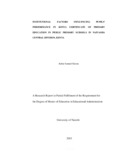| dc.description.abstract | The purpose of this study was to investigate the factors influencing the
performance of KCPE in public primary schools in Naivasha Central Division
Naivasha District.The study was guided by four objectives which included
establishing the extent to which teacher- pupil ratio influences performance,
examining the extent to which pupil–book ratio influences learners
performance, determining the extent to which frequent internal assessment
influences performance of learners and lastly examining how physical
resources influence performance of learners.
The research developed research questions to gather information in order to
meet the objectives of the study. Related literature to the study was reviewed.
The study was based on the ex- post factor research design focusing on public
primary schools head teachers, teachers and pupils in Naivasha Central
Division. The target population comprised of all the head teachers, teachers
and pupils in all the 29 public primary schools in Naivasha Central Division.
Data were collected by use of self administered questionnaires and data
analyzed based on descriptive statistical method. A pilot study was conducted
to test the reliability of the measuring instrument and was found suitable.
The study findings revealed that various types of factors in institutions that
influenced performance of learners in national examinations included teacherpupil
ratio, pupil-book ratio, frequent internal assessment and physical
resources such as libraries. The findings established that most schools in the
study area are highly populated hence affecting the teacher- pupil ratio and
pupil-book ratio which remained a concern of the head teachers and teachers is
the area. It also came out that in almost all schools in the study area administer
frequent internal assessments as a way of assisting and evaluating both the
teachers and the learners’ progress in syllabus coverage and in education
attainment.
Based on the findings it was found that only a small percentage of the public
primary schools in the area have physical resources such as libraries which can
help improve performance of learners in national examinations. Most of the
head teachers and teachers gave their opinion that the number of pupils
attended to by one teacher affects pupils’ performance either positively or
negatively. The larger the class, the more demanding the class is and
individual needs and interests of learners’ especially slow ones are not
adequately attended to. Smaller classes are comfortable to handle with
teacher- pupil ratio of between 1:30 and 1:40 per class.
Head teachers and teachers gave their opinion about pupil-book ratio. Most of
them agreed that there is a direct relationship between access to learning
materials and performance of learners. The more a learner is exposed to books
the more the learner acquires more information hence improved learning
outcomes. This was so to library resources where most of the heads and
teachers termed it as a base and a rich environment for knowledge acquisition
and exposure to information leading to improved learning outcomes.
Lastly the study concluded that frequent continuous assessment to pupils is
one formative way of evaluating learners and teachers use it to impart exam
answering skills to learners and also as a way of exposing learners to
answering questions as the pupils /candidates wait to be summative evaluated
during national examination. Thus frequent internal assessment is common to
all public primary schools in the study area. It was therefore concluded that the
level at which each of the head teachers and teachers is able to cope with the
challenges in his / her school concerning those institutional factors that
influence pupils performance in national examinations in public primary
schools is reflected in the performance index of that school.
Taking the limitations and delimitations of the study the researcher made the
following suggestions for further study; that a research should be carried out to
investigate the effect of teacher-pupil ratio in relation to slow learners; a
research should be done on the role of government policy in ordering
textbooks by schools instructional materials select committee; and a research
should be done to establish the relationship between head teacher’s training
and its effect on pupils’ performance in national examinations. The major
recommendations were that alternative ways of dealing with shortage of
teachers, and pupil-book ratio should be sort by both the schools and the
government. Head teachers should look for quality and relevant assessment
tests that will add quality to their pupils. Schools should not ignore the
importance of library resources and should therefore have library lessons in
the main timetable. Lastly, TSC should basically recruit teachers to cater for
staff establishment. | en |

